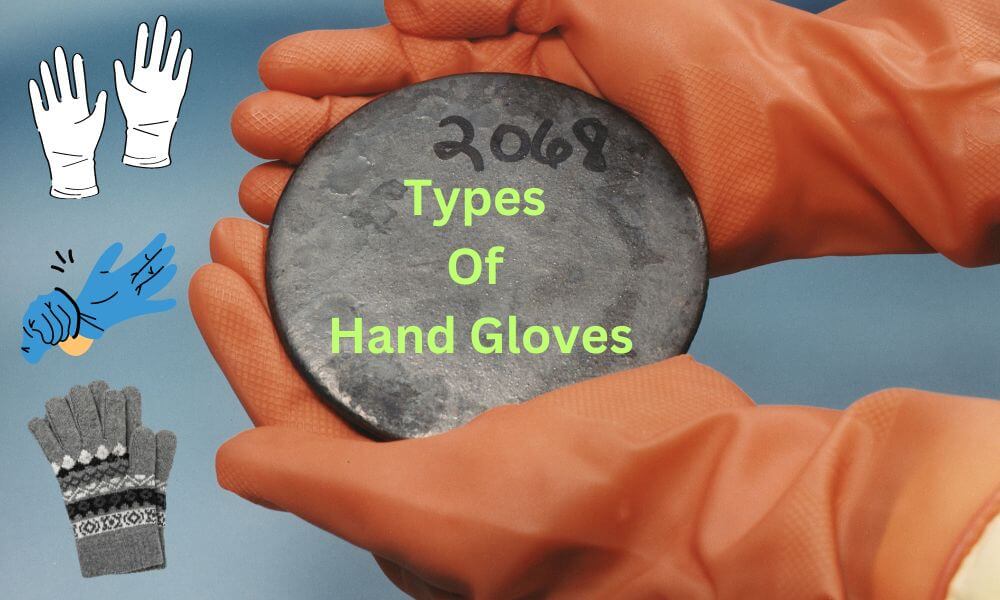Gloves are essential protective gear used for safety, hygiene, and fashion. There are many different types of hand gloves designed for specific needs and situations. Selecting the appropriate glove ensures optimal protection and performance.
Gloves come in a range of materials, fabrics, coatings and styles to suit the required protection level and use case. Factors like required dexterity, grip, chemical and heat resistance, and comfort help determine the ideal glove type.
This article provides an overview of common glove varieties, key differences, intended applications, and primary materials used in their construction. Understanding glove options and capabilities allows effective selection for your needs. The right gloves keep hands shielded from hazards and comfortable during use.
Types Of Hand Gloves
Following 8 different types of Hand Gloves are commonly used:
Work gloves
Work gloves are types of hand gloves that are designed to protect hands from injuries during manual labor, construction projects, and industrial work. They provide grip, durability, and padding for the hands.

Some examples of common work gloves include:
- Leather gloves – Made from cowhide or other leathers, these are very durable and provide excellent grip. Leather gloves protect against abrasions, cuts, and burns, and keep hands warm. They’re ideal for construction, farming, ranching, and other rugged tasks.
- Cotton gloves – Made of cotton fabric, these gloves breathe well and absorb sweat. Cotton gloves are lightweight and flexible. They provide protection against dirt, grease, and abrasions for general tasks like gardening and cleaning.
- Mechanic’s gloves – Designed for automotive repair, machine maintenance, and other mechanical work. These are usually made of synthetic leather for dexterity. Tight-fitting elastic or velcro wrists keep gloves secure. Some have reinforced padding for knuckle protection.
Work gloves vary by materials, padding, and wrist closures. Key features include breathability, flexibility, and protection against workplace hazards like chemicals, heat, cuts, vibration, and impact. Proper work gloves improve grip, reduce hand fatigue, and help prevent injuries.
Medical gloves
Medical gloves are worn by healthcare professionals to prevent contamination between caregivers and patients. There are several types of hand gloves in medical field designed for different needs:

Latex gloves
Latex gloves provide excellent sensitivity and fit for detailed work. However, some people suffer from latex allergies, so latex gloves may not be suitable for all environments. Latex gloves also have natural rubber proteins that can cause allergic reactions in sensitive individuals.
Nitrile gloves
Nitrile gloves are made of synthetic materials so they are a good option for those with latex allergies. Nitrile has similar durability and dexterity to latex without the latex allergy risks. Nitrile gloves are more resistant to chemicals than latex and also provide adequate protection against many infectious diseases.
Vinyl gloves
Vinyl (polyvinyl chloride or PVC) gloves are also suitable for those with latex allergies. Vinyl is more affordable than other glove options. However, vinyl has lower durability and is more prone to tearing during procedures. Vinyl gloves also tend to have lower puncture resistance. So vinyl may not provide adequate protection for more intensive medical procedures.
Chemical Resistant Gloves
Chemical-resistant gloves are types of hand gloves that are designed to protect hands from exposure to hazardous chemicals. They provide a barrier against corrosive and toxic substances like solvents, acids, oils, and some cleaning solutions.

Chemical-resistant gloves are commonly made from neoprene, natural rubber latex, nitrile rubber, polyvinyl chloride (PVC), and polyethene. Each material offers protection against some chemicals but not others.
- Neoprene gloves resist degradation from oil-based products like gasoline, solvents and some acids. They also withstand alcohol exposure.
- PVC gloves are durable and impermeable to block a wide range of chemicals like aldehydes, ketones and esters. They are not recommended for use with chlorinated and aromatic hydrocarbons.
- Polyethylene gloves provide an excellent barrier against most inert chemicals and solvents. They also resist permeation of fats, acids and petroleum hydrocarbons. However, they are not advised for use with chlorinated solvents.
The thickness of the glove material also factors into the level of chemical resistance. Thicker gloves generally provide longer breakthrough times and more resistance compared to thin gloves.
When selecting chemical-resistant gloves, it’s important to consult the manufacturer’s chemical resistance charts to match the glove material with the specific chemical being handled. Additionally, gloves certified to relevant standards (e.g. EN374 in Europe, F739 in the US) should be worn to ensure safe use. Proper wear and replacement at recommended intervals is also critical for effective protection.
With the right selection and usage, chemical-resistant gloves significantly reduce the risk of chemical permeation contact and absorption through the skin during handling. This prevents serious short and long-term health effects.
Fire Resistant Gloves
Fire-resistant gloves are types of hand gloves that are designed to protect hands from heat, flames, and electrical arcs. They are made from materials that do not easily burn or conduct heat. The two most common materials used are Nomex and Kevlar.
Nomex is a heat and flame-resistant meta-aramid material developed by DuPont. It does not melt or drip when exposed to flame and provides excellent thermal insulation and stability. Nomex gloves have a soft feel and allow good dexterity. They are typically used by firefighters, electrical and metal workers, race car drivers, and military personnel. The main benefits of Nomex gloves are:
- Provide protection from momentary contact with flames up to 370°C. Higher heat ratings are available.
- Do not melt, drip, or ignite when exposed to flame.
- Excellent thermal insulation properties.
- Durable and abrasion-resistant.
- Breathable and moisture-wicking.
Kevlar is an aromatic polyamide fiber that is spun into yarn and woven into fabric. Kevlar has high tensile strength, making it cut and abrasion-resistant. It does not melt or burn when exposed to heat or flame. Kevlar gloves offer protection from cuts, heat, and some limited flame exposure. Typical users include police, security, industrial workers, and military. Benefits of Kevlar gloves include:
- Cut resistant – provides protection from blades and sharp objects.
- Heat resistant up to 250°C.
- Flame resistant for short-duration exposure.
- Durable and abrasion-resistant.
- Good dexterity.
When selecting fire-resistant gloves, key factors to consider are the level of dexterity required, grip performance, thermal protection level, and durability. Proper sizing and testing is also important to ensure adequate protection and comfort.
Cold Resistant Gloves
Cold-resistant gloves, sometimes called winter gloves, are types of hand gloves that are designed to keep hands warm and dry in cold weather conditions. They are made from materials that provide insulation against the cold while also being waterproof and breathable. These types of gloves are essential gear for activities like skiing, snowboarding, ice fishing, snowmobiling, and any other winter sports or tasks carried out in frigid temperatures.

The outer shell of cold-resistant gloves is usually made of waterproof and windproof materials such as leather, synthetic leathers, or tightly woven nylon. These materials repel moisture while blocking wind and cold air. Many winter gloves also have an inner waterproof membrane like Gore-Tex to further enhance waterproofing while allowing internal moisture and heat to escape.
Insulation inside cold weather gloves helps retain body heat and keep hands warm. Common insulators include wool, silk, fleece, and synthetic materials like Thinsulate or PrimaLoft. The amount and type of insulation can vary based on the intended activity and temperature rating. Lightweight insulation works for mild winter weather while heavy insulation is better for extreme cold.
For maximum hand protection in the harshest winter conditions, some cold-resistant gloves have extra features like removable inner liners for warmth and moisture management. Glove inserts allow you to customize insulation levels. Other features may include adjustable wrist straps, touchscreen-compatible fingertips, reinforced palms, and clips for attaching gloves together.
When choosing cold-weather gloves, it’s important to consider factors like temperature rating, dexterity, grip, and intended use. Proper sizing is also key to ensure the gloves seal out the elements without restricting mobility. With quality materials and construction, cold-resistant gloves can make winter sports and activities much more comfortable and enjoyable.
Cut Resistant Gloves
Cut-resistant gloves are types of hand gloves that are designed to protect the hands from cuts and lacerations while handling sharp tools or materials. They are commonly used in industrial settings like manufacturing, construction, oil and gas, metal fabrication, and more.
These gloves are made of cut-resistant materials like high-performance polyethylene fibers, Kevlar, or stainless steel mesh. The most common materials used are Dyneema and Spectra fibers which are stronger than steel and provide durable cut protection.
Cut-resistant gloves protect against injuries from sharp edges on sheet metal, glass, ceramic and metal parts. They provide a high level of dexterity and flexibility compared to metal mesh gloves.
The level of cut resistance is measured using the EN 388 standard which rates gloves on a scale of 0-5 based on the amount of force they can withstand. A higher rating indicates better cut-protection. Most cut-resistant gloves have a rating of Level 3 or 4.
When selecting cut-resistant gloves, it’s important to consider the cut risk level, fit and comfort as they need to be worn for extended periods. Proper sizing ensures good dexterity and a snug fit. The gloves should be inspected before each use to check for any tears or holes which can compromise their protective value.
Using cut-resistant gloves helps prevent lacerations and finger amputations, avoiding lost time accidents. They provide peace of mind when working with potentially dangerous sharp tools and materials.
Disposable Gloves
Disposable gloves are types of hand gloves that are designed for single use applications, after which they are thrown away. They are commonly made from thin latex, nitrile, or vinyl materials that provide protection while maintaining dexterity.
Disposable gloves are widely used in medicine and healthcare settings to prevent cross-contamination between care providers and patients. Doctors, nurses, dentists, and technicians wear disposable gloves during exams and procedures. After use, the gloves are removed and disposed of properly to prevent transmitting germs. This helps maintain sanitary conditions and prevent spreading infections.
Food service workers also wear disposable gloves while preparing food, handling raw meat, or cleaning. This protects the food from contamination and helps maintain hygienic standards. The gloves are replaced frequently, such as after touching raw meat or switching tasks.
Disposable nitrile gloves are ideal for automotive workers, janitors, cleaners, and chemical handlers. The nitrile material is more resistant compared to natural latex. Those with latex allergies can also safely use nitrile or vinyl disposable gloves.
For light tasks that don’t require heavy protection, people often use disposable gloves for chores like cleaning, painting, gardening, or home repairs. They help keep the hands clean and offer some protection from dirt, chemicals, oils, and detergents. Most disposable gloves are ambidextrous with a one-size-fits-most design.
Dress gloves
Dress gloves are types of hand gloves that are designed for fashion and come in materials like leather, cotton, and silk. They are worn for formal occasions or evenings out.
Leather gloves are the most classic and luxurious option for dress gloves. Fine leather gloves are elegant and evoke the sophistication of old Hollywood. Available in a wide range of colors, leather gloves can complement any formal outfit from a cocktail dress to a tuxedo. They are warm for winter events yet lightweight enough for spring and fall. Opt for longer leather gloves that reach near elbow-length for the most glamorous look.
Cotton gloves provide a lighter, more breathable option for warmer weather. Made from woven cotton fabric, they have a breezy, springlike feel. Cotton dress gloves are ideal for garden parties, daytime weddings, and summer events. Look for pretty details like lace, embroidery, or pleating to elevate the style.
Silk gloves have an ultra-feminine, delicate aesthetic. The fabric is luxuriously soft and smooth. Silk gloves drape beautifully on the hands and come in vibrant jewel tones as well as classic black and white. They add a touch of sophistication and old world charm to any formal ensemble. From opera-length evening gloves to wrist-length day gloves, silk is always an elegant choice.
Types of Hand Gloves : Conclusion
There are many different types of hand gloves designed for specific uses and environments. The key glove types covered include:
- Work gloves – Made from leather, cotton, or other durable materials to protect hands from cuts, scrapes, heat, cold, and impacts during manual labor and industrial work. Key features are abrasion resistance and grip.
- Medical gloves – Latex, nitrile, vinyl disposable gloves worn by healthcare workers to prevent contamination between patient and healthcare provider. Provide protection against blood borne pathogens and infectious diseases. Non-latex options available for those with latex allergies.
- Chemical resistant gloves – Protect hands from corrosive and toxic chemicals like solvents, oils, and cleaning agents. Made from materials like nitrile, neoprene, and other synthetics that resist permeation. Critical for protecting skin from chemical burns.
- Fire-resistant gloves – Made of Nomex, leather, or other fire-retardant materials. Designed to insulate hands and withstand high heat while allowing dexterity. Used by firefighters, welders, and other professionals exposed to extreme heat.
- Cold-resistant gloves – Insulated with wool, down, PrimaLoft and other synthetic fills. The waterproof outer layer provides warmth and protection for hands in cold winter activities like skiing, snowboarding, and mountaineering.
- Cut-resistant gloves – Reinforced with materials like kevlar, Dyneema, and stainless steel to protect hands from severe cuts and lacerations when using knives, cutting tools, and sharp machinery. Used commonly in food processing and industrial settings.
- Disposable gloves – Single-use natural rubber latex or synthetic gloves for tasks like food handling and janitorial work where cross-contamination is a concern. Also used as a barrier for chemicals, pathogens, and biohazards.
- Dress gloves – Elegant fashion gloves made of fine leathers, cotton, silk, satin, lace and other fabrics. Traditional formal accessory for events and occasions. Main function is aesthetic rather than protective.
The wide range of specialized gloves allows people to safely work with their hands in almost any environment or application. Proper glove selection is important to ensure adequate protection and dexterity for the task at hand. With the right pair of gloves, hands can be kept clean, warm, cool, safe, and comfortable.
Please Like Our Facebook Page | Home
